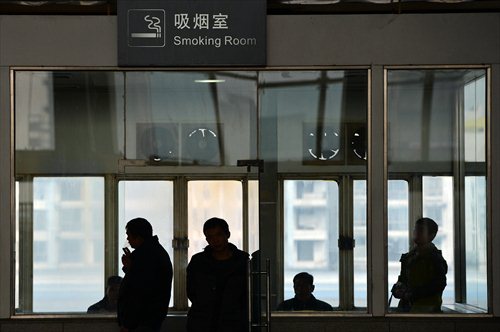
Smokers keep the door of a smoking room open at a railway station. Photo: CFP
China is ramping up its efforts to control smoking with 44 cities newly introducing or revising regulations in 2023, bringing the total number of cities with relevant regulations to 254 nationwide, according to national health authorities.
According to the Xinhua News Agency, 24 regions at the provincial level in China have rolled out regulations on smoking, with the proportion of the population protected by comprehensive smoke-free regulations continuing to increase, experts from the National Health Commission (NHC) released the data on Saturday ahead of the World No Tobacco Day on May 31.
Meanwhile, as China pledges to protect 80 percent of its population with smoke-free laws by 2030, experts on tobacco control on Sunday called for the country to introduce a national smoking control regulation as soon as possible.
Smoking control, including preventing smoking and encouraging smokers to quit, is a viable approach for both population-wide disease prevention and individual health care, according to Wang Lu, a health expert from the NHC.
Curbing smoking doesn't aim to deprive people of their right to smoke, but to free people from being hurt by secondhand fumes, Zhang Jianshu, a senior expert at the Chinese Association of Tobacco Control, told the Global Times on Sunday.
China ratified the World Health Organization Framework Convention on Tobacco Control in 2005 and began enforcing it in 2006.
The country has decided, as outlined in a document released in 2016 aiming to build a healthier China, to intensify tobacco control through pricing, taxation and legislation. It also aims to promote the building of smoke-free environments and strengthen supervision and law enforcement in public places.
The document aims to decrease the nationwide smoking rate among individuals aged above 15 to 20 percent by 2030.
Recent years have witnessed active legislative efforts by local authorities to control tobacco.
Beijing, for example, prohibits smoking in public places, indoor workplaces, and outdoor queues. The city of Shenzhen has put in place a ban on smoking in indoor workplaces, indoor public venues, public transportation, as well as outdoor areas in schools, parks and medical institutions.
Thanks to relentless anti-smoking efforts, the adult smoking rate has decreased to, for example, 19.4 percent in Shanghai.
Nationwide, the smoking rate among the population aged 15 and above stood at 24.1 percent in 2022, down by 1.7 percentage points compared with 2020, data shows.
However, some experts said that some areas in China still face challenges to realize the national goal to protect over 80 percent of its population under smoke-free legal protection as of 2030.
For example, in Beijing, there has been a transfer of enforcement authority for tobacco control, which has led to some difficulties in enforcement, Zhang Jianshu revealed.
According to Zhang, previously, tobacco control enforcement was carried out by the health supervision department, with clear responsibilities and relatively positive results. However, since 2020, the enforcement authority for tobacco control has been transferred to the city's comprehensive law enforcement responsibilities, mainly carried out by urban management officials. Due to the diverse responsibilities of urban management personnel, there is a significant gap in the enforcement intensity compared with previous.
As a result, the enforcement of indoor smoking bans in Beijing is not very satisfactory, Zhang noted.
He explained, in the past, tobacco control enforcement involved simple fines for violators, but now, to avoid arbitrary penalties, the enforcement procedures have become more complex, leading to increased enforcement costs on time and resources, which has made urban management personnel less able to actively enforce these regulations.
According to the World Health Organization, tobacco kills more than 8 million people each year, including an estimated 1.3 million non-smokers who are exposed to second-hand smoke. Over 1 million people die of tobacco-related diseases in China every year, and this number will rise to 2 million per year by 2030 and 3 million by 2050, according to the Report on the Health Hazards of Smoking 2020 jointly released by China's National Health Commission and the World Health Organization China Office.
In terms of economic impact, the economic losses caused by tobacco far exceed its contribution to government tax revenue, Zhang pointed out.
As we consider life as priceless, the emotional impact on individuals, families, and friends, as well as the cultural and spiritual wealth created beyond the economy, the loss of life due to smoking prematurely is immeasurable and cannot be balanced or offset by any amount of income in the billions, Zhang stressed.
With the increasing population mobility, including the impact of tourism development, national tobacco control regulations should be implemented as soon as possible to fulfill China's commitment to its people and the international community on tobacco control, Zhang urged. He noted that strengthening tobacco control is a reflection of social progress and civilization.




